This interview was conducted with me, Ash Ambirge, over Zoom phone, and was recorded and transcripted. The final piece has been edited for clarity.
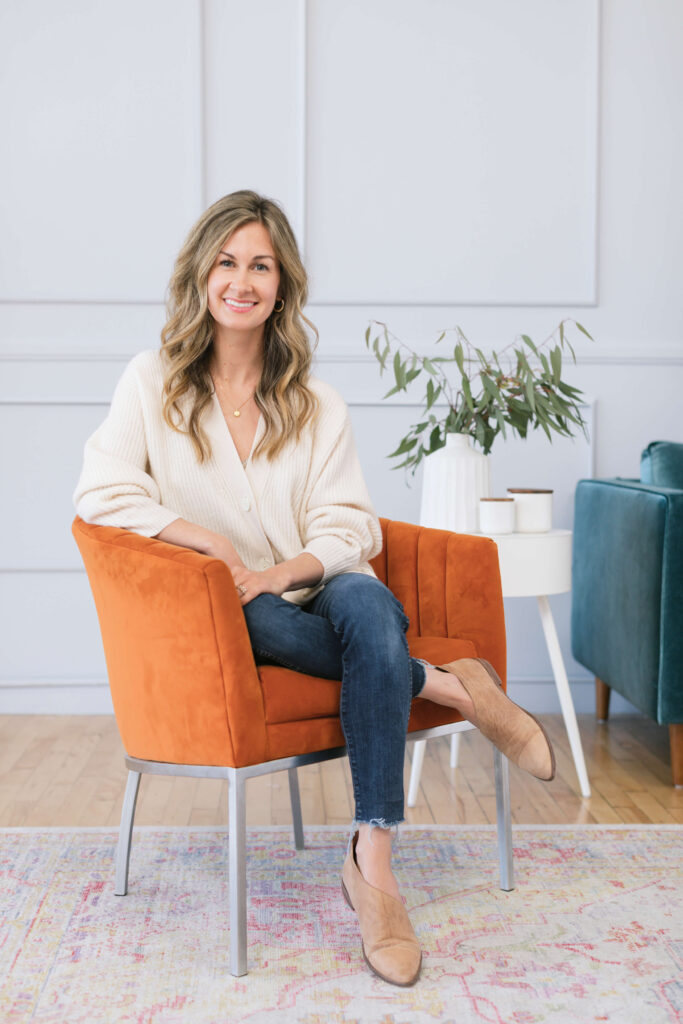
“I was a bartender,” she tells me—and I nearly shit my pants.
Not because I had eaten a rotten slab of rib-eye—though I’m thrilled to start with that imagery—but because successful people usually skirt around the less glamorous things they had to do to get where they are.
“I didn’t want my life, my rents, my livelihood to be dependent on the business in the first year.”
It’s only the first of many clues that this interview is gonna be gooooood. (That, and the fact that she cringes when I ask her the story behind the number “45” in her business name. “Oh my gosh, the worst: I came up with this name and then, of course, the devil himself becomes the 45th President of the United States.”)
Other clues include things like:
- She didn’t use social media to find her first customers. (Just wait until you hear what she did instead.)
- She doesn’t use fabricated deadlines and countdown timers to convince people to buy. (”You shouldn’t have to convince people,” she says with thoughtful disdain.)
- Instead of scarcity, she operates from a place of generosity—and it’s “significantly changed” her business.
- And she gave up her first company—hence the moonlight bartending—because “I just didn’t have any passion left for it.”
But, okay, let’s start from the beginning.
Because, how does one reinvent themselves again from scratch, going from zero dollars and zero subscribers and zero followers, to earning $960,000 a year—and on track to earn much more—all while working just a few hours each morning?
Well, it starts with knowing what you care about.
In 2011, Shannon Lohr cared about sustainable fashion. So much so, she and her friend Kristin set out to make a piece of clothing that could be worn 15 different ways: as a skirt, dress, hood, scarf, purse, poncho & more. And here we must pause, because two things are wild about this story:
- I remember this from 2011—I backed her Kickstarter campaign, because what better piece of clothing for a traveler?! 🤯
- The name of the product? The Versalette. We laughed so hard on the phone about this. Clearly it’s the cool older cousin of The Vivette. waves
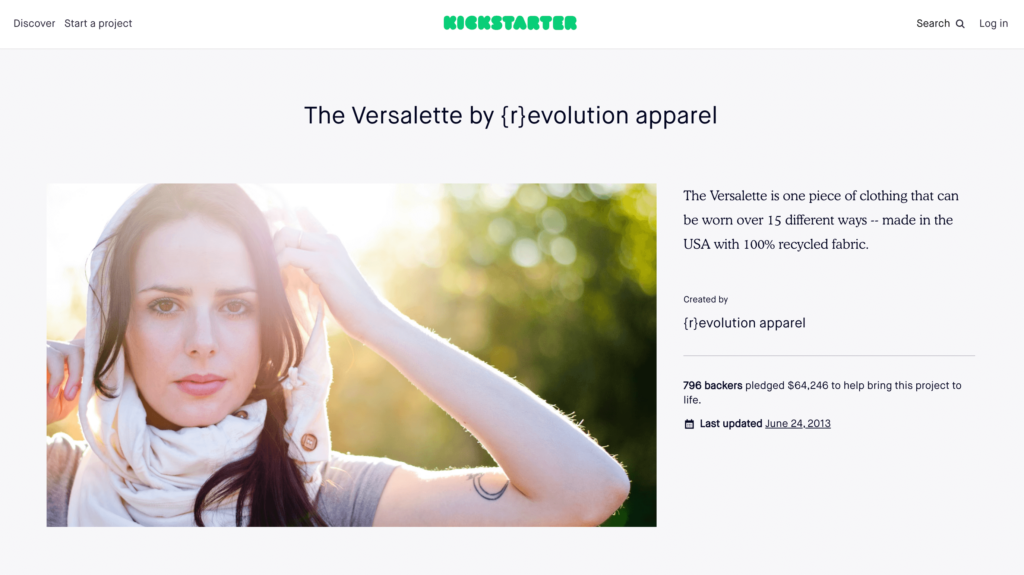
The Kickstarter campaign was a surprising success, bringing in $64,246 in initial funding. They were bowled over. They hadn’t even made The Versalette yet, and hardly had expected it to be such a hit. Cue: two women who had to—quickly—figure out how to manufacture a piece of clothing.
Note: for everyone who’s ever thought, “I should design a tee-shirt that doesn’t make me look like a frumpy Florida woman named Marge,” listen up—this next part is fun.
Next thing you know, Shannon and Kristin are learning—in true trial by fire fashion—how to source sustainable fabric, contact suppliers, actually get responses from suppliers, learn sewn manufacturing techniques (so many question marks???), create design sketches, make professional spec sheets, get “production-ready patterns,” understand the numbers, run cost analyses (haha best of luck), find sustainable packaging—and, you know, launch a new sustainable fashion brand.
Guess who took notes?
Guess who took a lot of notes?
Cut ahead to 2014.
Shannon now knows a lot. A lot of people want to know what Shannon knows. Because honestly, nobody knows what “sewn manufacturing techniques” are. 😅 (Unless you do, in which case, GLOAT ON.)
She decides to start consulting with other sustainable clothing brands. It feels like a fun new breath of fresh air. She becomes passionate about supporting the sustainable clothing industry in a bigger way. The Versalette was only the first step.
Like she wrote on the original Kickstarter page:
It has become more about the effects of pesticides for cotton crops and the hardships of exploitative factory work. All so that the rest of us can consume. And throw out. And consume again. Over and over, until we realize that things will never truly fulfill us.
This decision—the decision to care about her work on an even bigger scale—was the moment when everything changed again.
Now, lemme ask you: if you were an accountant in Minnesota (god help your soul), and one day you decided that you no longer wanted to be an accountant—you wanted to strike it out on your own, and consult with accounting firms on a bigger scale—what would your first move be? Where would you get your first clients?
This is the part where most people get stuck holding an eggplant in their hand. 🍆 😊 It’s scary! It’s hard to know what to do. How can you make that leap? IT’S A BIG LEAP.
For most people, social media is the first obvious answer. But, then you immediately vomit because the thought of it all is just 🥴. Who wants to feel like an overeager beggar? Who wants to tapdance around, performing for strangers? For many, it’s the ultimate performative act of false sincerity: it can feel like being put on stage in a bunny costume. And, how are you supposed to sell authentically that way?
Shannon, however, had a different plan. She had gone to school for journalism, so the written word came naturally to her. So, she decided to approach the task in a different way: she would set out to write thirty pieces of content and publish them across the internet—guest posts, articles, interviews *on other people’s sites—*and then ask readers to subscribe to her new email list if they were interested in learning what she knew.
She got ten emails.
Then twenty.
Then fifty, a hundred, and soon two hundred.
And, turns out: those couple hundred emails were enough to launch a whole new identity.
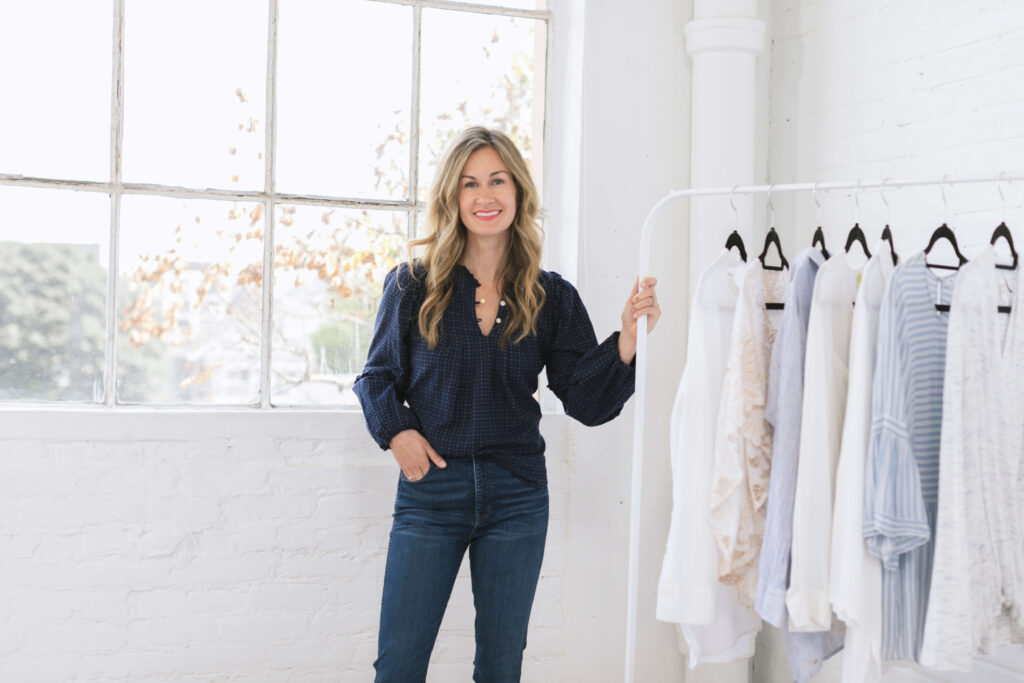
At this point, Shannon could have got stuck. Started spinning. Waited until she had a thousand people on her email list. Maybe 5,000??? Maybe 10,000? When are you good enough to make the world an offer? When are you “legit” enough?
She also could have gone in the opposite direction and tried to launch some big, shiny new company before she was ready…or had her ideas fully formed.
But fortunately, Shannon is smarter than most of us twats, and so she decides to go ahead and do the opposite of what most of us would do: she decides to start out—ready for this?—slowly. (That’s a thing.)
She calls her new consulting business FACTORY45—”It was arbitrary, but I liked the alliteration.”
She agrees to take on ten mentees to begin—and only ten. She will not overextend herself. She will not take on more than she can handle. She will not fall prey to the temptation to say yes to everyone who comes across her inbox.
Instead, she sticks to ten mentees. Whom she will mentor in a group. And together, they’ll work for 6 months to launch ten new clothing brands.
She sends out an email to her list of a couple hundred people announcing a pre-sale on her new mentorship program. It wasn’t starting yet, but you were invited to apply. There were only ten spots. (This was key.) And it would cost $3,000 per person—or $500/month.
She had thirty people apply.
Still, she only took on ten.
That year, she made her first $30,000 as a consultant in the industry.
But—and this is the best part—kept her job tending bar.
”It’s important to note: in 2014, I reinvested that $30,000 back into the business for the following year and I kept on bartending at night. I didn’t want my life, my rents, my livelihood to be dependent on the business in the first year. I think that’s a mistake a lot of people make: you’re not setting yourself up for the long game.”
Shannon is an expert in the long game. (And, of course, this was the moment when I said to myself: so this is what a controlled human being looks like.)
There’s a big takeaway here and Shannon is our leader: it’s not just okay to go slowly, it’s a whole mfing strategy. You don’t have to have 500 clients in the first year. You don’t have to make one million dollars by the end of Q4. Slow can be preferable. Slow can be by design. And maybe the expectations we place on ourselves should be, dare I say it, reasonable.
Ten clients feels pretty reasonable to me.
So does $30,000 out of the sky.
Here’s what she said about the pre-sell process:
”I said I’m only going to work with 10 people for the inaugural launch. And then, what I did was I pre-sold those spots and I made an application process, so I built [in] some exclusivity, and 10 people were going to get chosen. And then I had one module written and recorded of the program, and that’s it: I created the rest of the program as the program was happening. Anyone who like creates an entire online course before they’ve sold it is crazy to me, unless you have a huge following and know you’re going to be able to sell it. But I I love, love, love a pre-sale strategy for any business.”
Another takeaway: exclusivity can help you reach your goals more than opening the gates and letting the whole wide world in. While it’s tempting to think that limiting your availability will limit your income (and you should let everyone in, if they want) oftentimes the opposite is true: the more you restrict your availability, the more demand you create.
This isn’t anything new to the online world: it’s the universal law of supply and demand. In other words: you always want a waitlist. If you don’t have a waitlist of a few hungry customers, you’re doing it wrong.
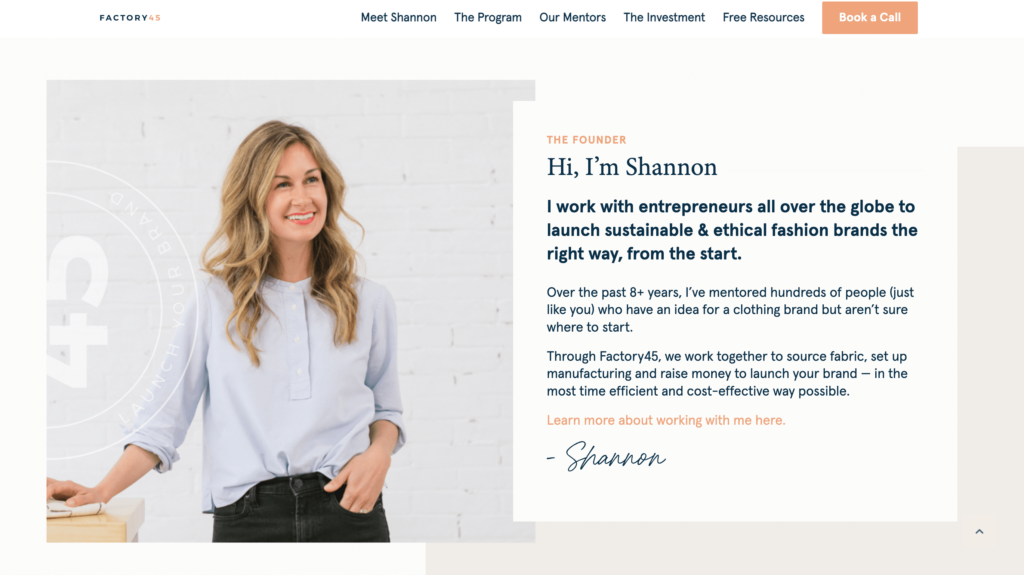
That year, Shannon worked with those ten people, and only those ten people. She built out a process. She saw what worked and what didn’t. Then, she re-launched her consulting program again after a year.
This time, she welcomed 30 new mentees.
Then, in the fall, she opened her doors again, and took on another 30 people in the fall.
All the meanwhile, she was writing once a week, on Wednesdays, to her email list. “The email list is everything and it’s my main marketing,” she told me. “Start email marketing as soon as you can. Get a landing page up. Start sending emails. Sharing behind the scenes. Sharing your origin story. Rolling out a personal connection.”
Her second year in business, she earned $180,000. (We like math when it looks like: 60 mentees x $3000 each.)
The following year, in 2016, she would have her first $270K year. She had ninety people sign on as mentees. If you’re wondering how the hell that works—ninety people?—I’m going to share her system below. For the meantime, however, know that it was a group coaching program, not one-on-one. And this is a theme you’re going to be seeing throughout the Vivette Business series: the most successful online businesses are the ones that understand how to leverage their time. That there are many ways to help your clients, but only a few ways that give you freedom.
So, how many people did she have on her email list to get ninety clients to sign up for her paid program?
Seven hundred and fifty.
Less than a thousand.
And they all came from Shannon’s quiet determination to simply send one email every Wednesday. Nothing over the top, but fiercely consistent.
Like I said: master of the long game.
And like she told me in our interview: her efforts started to compound.
Thereafter, Shannon did one launch every year. Each time, she earned more and more. But, she was doing all of the work herself. “I answered every question from every student for eight years: at some point, you need to remove yourself from the day to day.”
In 2021, Shannon’s new goal was to scale.
So, in true Shannon-like fashion, she did things her way: slowly and with care.
She brought in a mentorship team—13 alumni hand-picked by Shannon—that now act as mentors in the program. (They’re contractors she pays on a monthly retainer, and they’re available on Voxer to answer on-the-fly questions from mentees.)
She holds a monthly masterclass and answers questions in the Facebook community every morning—but after that, she shuts her computer to go live her life.
She shifted her ideal target market from “just graduated from fashion school” to “in her 30s and wants a creative outlet from a corporate job, or is leaving a corporate job or have savings or a spouse or partner and have more disposable income”—a change inspired by the people she saw most attracted to the program during 2020.
And? She doubled her prices, going from $3,000 for the program to $6,000—and with it, offered lifetime support. (Now that she has more support herself.)
Then, she did three launches instead of one: March, May and October.
That year, for the very first time, her business pulled in just short of a million dollars.
She stopped bartending a while ago. 😀
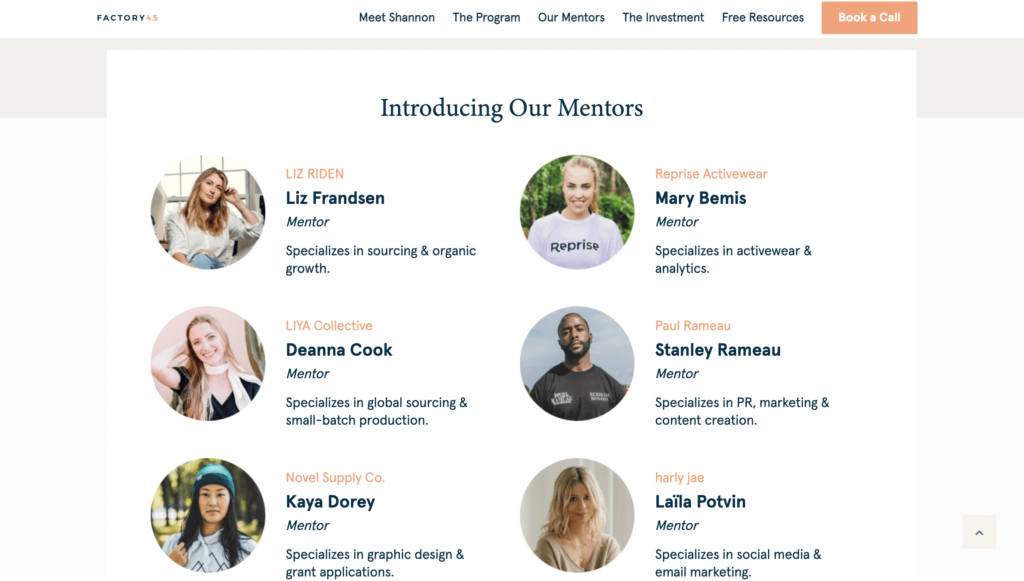
At present, there are 160 mentees in the Factory45 program, and it’s growing every day. 💥 From a revenue standpoint, that’s $960,000 already this year, and it’s certainly not over. Her email list is active with 12,600 subscribers, and she’s managing her time like a champion with her four-year-old and 3-month-old at home.
And let me tell you: the way she has everything organized is impressive. So, I hounded Shannon to tell me, in-depth, how it all works from start to finish.
Here’s the behind-the-scenes of how Shannon’s business works:
- A new subscriber opts into Shannon’s email list.
They’ve found her through the content marketing she continues to do, publishing new content every week to her blog and to her email list, and finding opportunities—much like this one—to get published on other people’s blogs and newsletters. I asked her if she runs paid ads and she told me that they’d only ever run them during live launch periods—but that “organic and word-of-mouth referrals are our top sources.” - New subscribers receive a welcome series of emails.
This is accomplished automatically using software like Convert Kit. (Shannon uses Active Campaign.) The first email she sends features other brands that have launched through Factory 45—essentially serving as gorgeous social proof and testimonials right up front.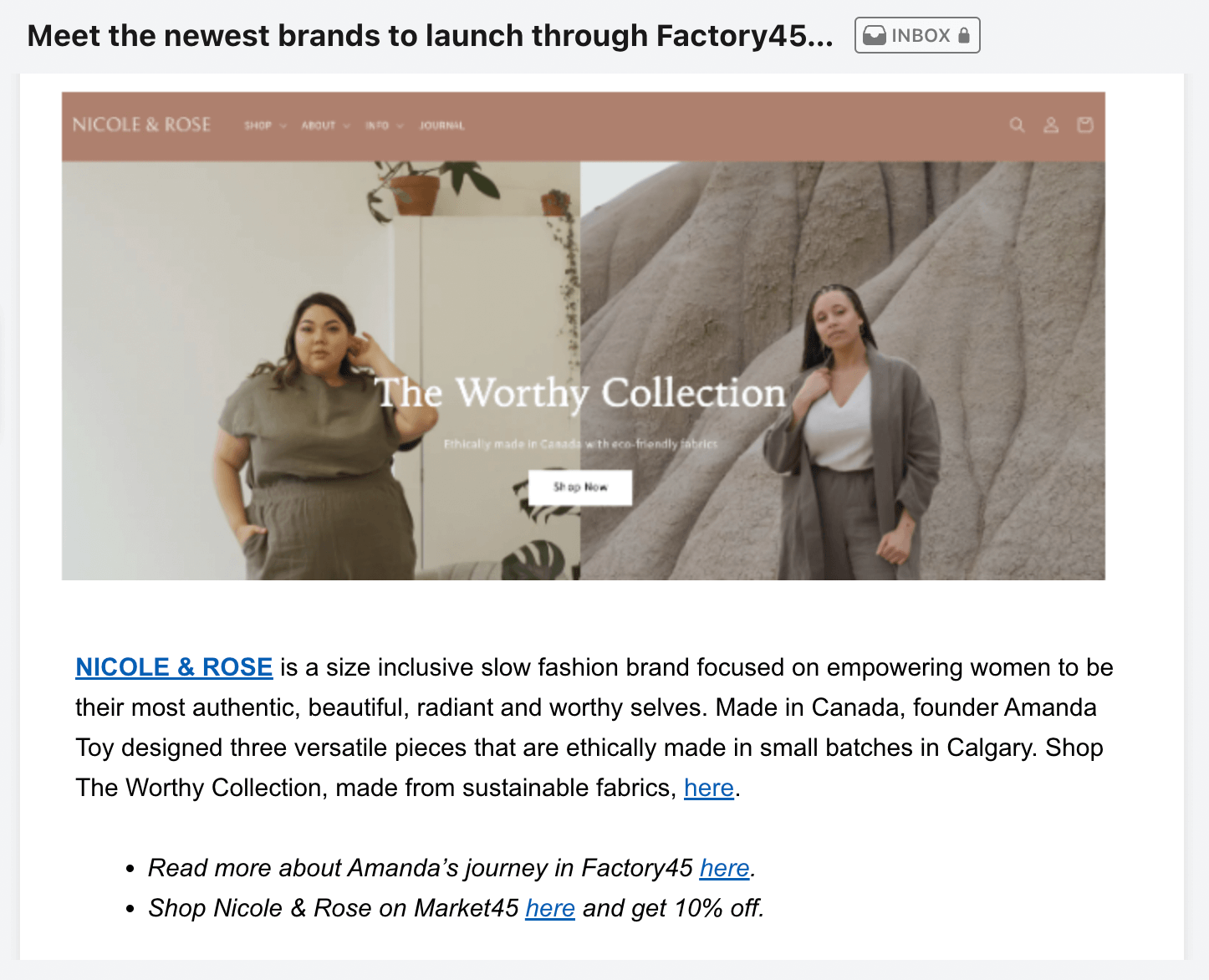
- She ends each email with an unusual call-to-action: book a call.
We talked at great length about the decision to make her main call-to-action “book a call” instead of “sign up now.” Because, let’s face it, she could just link you to a sales page and hope you submit payment and get started. “At the $6K price point, people want to talk to somebody. There’s something to be said for the application process and that’s something I don’t really want to get rid of,” she tells me. “But asking them to book a call has been effective. Had I done this in 2020, we would have hit our first million then.” I continue to press for details. I confirm there’s no big sales pitch; no big deadlines; no big countdown for new subscribers to prod them into action. This is when she tells me she doesn’t think you should have to convince someone to buy. “We don’t have price incentives for urgency. It’s definitely not foolproof: if people can procrastinate they will procrastinate, but at the same time, you don’t want to have to convince people to join your program. They’re either going to see the value and want to do the work, or they won’t: but the people you have to convince… you don’t want those people.”
- Book a call leads to a Calendly calendar, where you can select a time to talk to someone named Hannah.
Genius move, so the phone isn’t ringing at unexpected times. But moreover, hiring someone to handle incoming inquiry calls just feels like freedom, does it not? Hannah’s job is to talk to you about the program and see if it’s a good fit—but there’s no high-pressure sales tactics, no special price offers, no urgency applied. The only urgency is the truth: we’re starting another round this [DATE]. That’s coming up soon. Do you want in?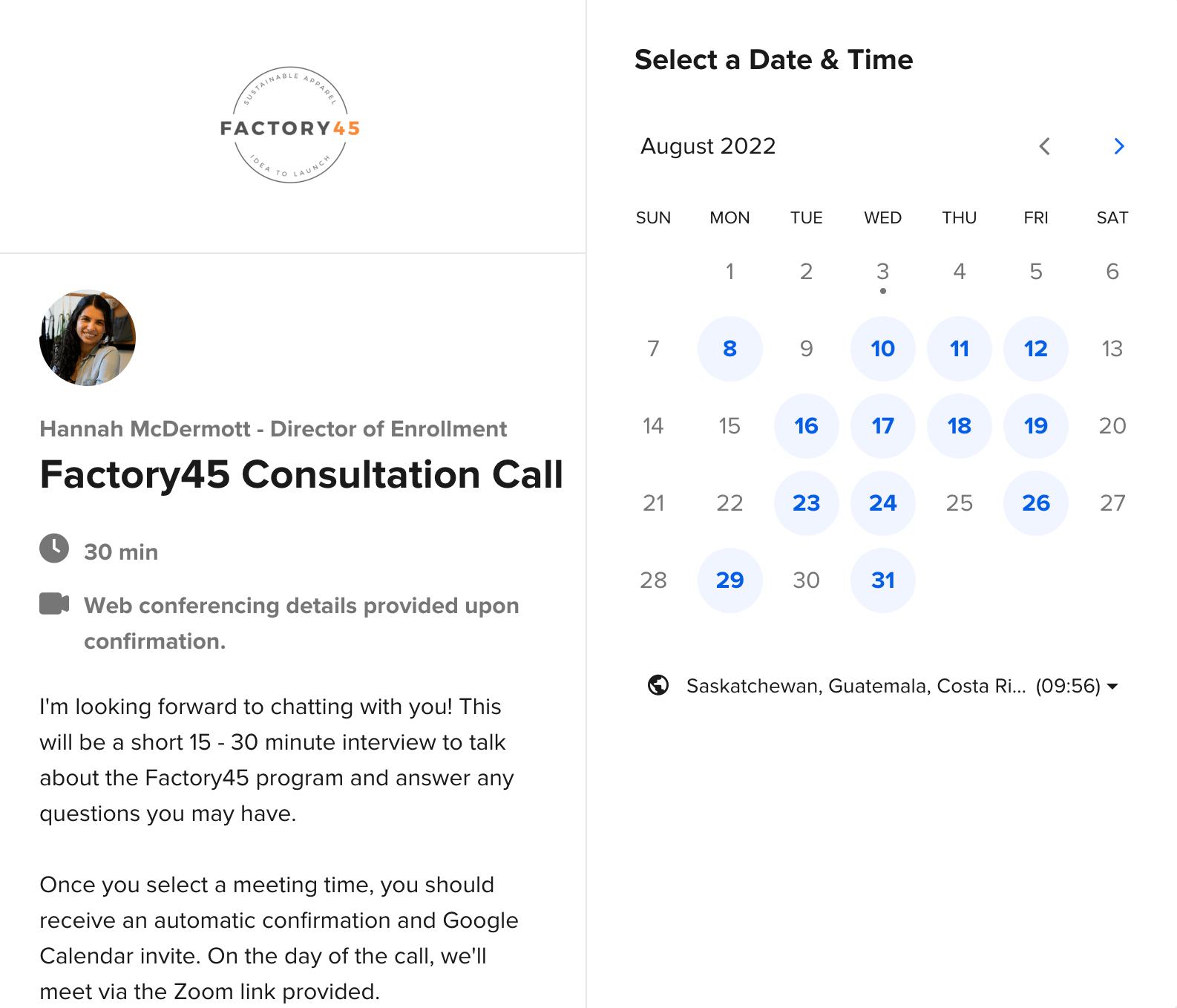
- If someone visits the booking page but doesn’t book a call…
They have an email automation that will follow back up with that person. Isn’t technology wonderful? (Of course, they have to already be on her email list for this to work.) Then, they’ll continue to get their weekly emails, of course, nurturing the relationship into an eventual sale.
- This is all part of a bigger effort to do rolling admission.
There are no more yearly launches: the strategy since 2021 has been a rolling admission, meaning new mentees can join Factory45 anytime. They go through the program at their own pace. And they join in real-time calls and ask questions in the community, all together with everyone else. When I asked her if there was ever any problems since students were coming in at all different stages—and therefore asking all different levels of questions—she thought for a moment and then said no: “The thing is, even if they were to start the program all together, they’re all at different stages, you know? Everyone’s on their own journey, so it’s not an issue.” - Once you sign-up to Factory45, you get access to the whole program right away.
This is different than a lot of programs you see like this who “drip” content out, little-by-little every week. The common wisdom is that this prevents two things: (a) Bad actors from coming in and stealing all of your content, and (b) Students from purchasing, going through it all in a couple of weeks, and then requesting a refund….before they’ve paid off their installment plan, for example. And, this was how Shannon ran Factory45 up until 2021—but, once she started doing multiple launches, it got complicated. So, despite being admittedly terrified, Shannon decided to streamline it all. That’s when the rolling admission started. And that’s when she decided that all new students would get full access to the program up front, as soon as they signed up. And you know what shocking thing happened???
”I was so afraid I was afraid to do this. I was like ‘people are just going to like access everything and then drop out, or just going to do everything within 30 days.’ I was so afraid, and then it ended up like being the opposite. Out of every ninety students, we had maybe 5 drop out. But now? Our drop-out rate has gone down significantly.”
She emphasized significantly, and we talked about how refreshing this was, given that again: it’s the opposite of “standard wisdom.”
- The one thing she does keep on drip? Her post-purchase email campaigns.
Even though you can enroll in the program and access it all at once, you’ll still get timed emails each week—every Monday at 9am Eastern—that guide you through the process. “I have a suggested timeline and so everyone is on an automation where every Monday at 9am Eastern they get an email. And it will say in the subject line: Module One, Week One, the title of that lesson, you know. And then it’s an email from me: Hi, oh happy Monday, here’s what we’re learning this week, this is where I want you to start, here are the live calls that are scheduled, don’t forget to reach out to your mentor for support. And so that kind of keeps them on a schedule, so even though they could go to Module Five, it tells them this is the first module to focus on.” - Then, there’s the Facebook community.
Shannon gets in the Facebook community every morning during the week and answers any questions from students. I asked her how she handles boundaries around this. This is when she reveals she doesn’t even have a personal Facebook account. She says: “That’s a good question: I got off Facebook from a personal standpoint, like, completely. So, I just have a dummy account that I run my business through—I mean it’s not really a dummy account, but I don’t have any friends, I don’t have anything in my news feed, I just purely go to interact with Factory45 students. I’m on Pacific time so I try to do it as one of the first things I do. But, you know, it doesn’t always happen. I don’t really stress about it: I know that I’ll get to it and it doesn’t usually take that much time. I also have two kids—I just don’t have time for being on Facebook all day long, so that helps.” And, I absolutely loved this. When running a group like this, there’s oftentimes a lot of internalized pressure to be available, not let a question hang for too long, be “on it.” But, Shannon’s carved out a routine that works for her—she does the routine, and then she’s done. Which, frankly, sounds liberating. - Having 13 alumni mentors on staff helps.
One of the reasons why she feels so free to live her life and not always be connected? She’s got a team of 13 alumni mentors who are available via email and Voxer for anything that comes up. Each mentor specializes in something different, and if a mentee is on the phone with a supplier and something comes up? They can Vox a mentor and ask a question on-the-fly. I was fascinated by the approach, and asked her how she worked it. “They’re hand-picked alumni by me. They have the opportunity to come on as contractors. They’re available 9-5 in their time zone, but in general have a 24-hour window to get back to someone. We use Voxer for text messaging support. I pay them monthly…and I probably overpay them.” She laughs. But, then again, she adds: “What price will you pay to get your time back?” An important addition. - Ultimately, if someone isn’t in a position to join Factory45? There’s always digital products.
Known as “downsells” in the online business industry, these are downloadable products that are available at a much lower price point to help bridge the gap between where someone is at, and where they want to be. But, they also help bridge any gaps in revenue if you’re not able to commit $6,000 a year for the program. Shannon’s got a Fabric Sourcing Kit ($59), a Manufacturing Kit ($97), and a Crowdfunding Kit ($197). These are located in her shop, but she’ll push you toward these via email automations if you haven’t been able to sign up for the full Factory45 experience.
It’s a solid system, and it’s working: Shannon is on track to blow past her goals this year…and thensome. But, when I ask her what’s next, she hits me with another big dollop of sensible, grounded, ever-profound Shannon wisdom:
”I could scale to 5 million, but I know what that would take and I’m just not sure that I want to sacrifice my day to day life for it.”
I want to scream. Shout. Raise my fists in the air. This is the kind of call-to-arms we need right now. She elaborates:
“I have a three-month old. So, I literally have to say no to everything, other than people in my program and opportunities like this. It helps you prioritize and you kind of have to find that thing. Like, for me it’s like this baby that’s latched onto me. But for other people, you have to find that thing that is going to force you to say no to things and to make sure that you’re living the life you want to live.”
And she’s doing exactly that. She’s leveraged her hard-won knowledge and turned it into her greatest asset: something she’s created from her mind, put on paper, developed into a program, that she can now use to guide the sustainable clothing industry in a bigger way than ever.
But, perhaps the most inspiring thing about her journey is the realization that you can have big dreams and small, manageable time commitments. You don’t have to make yourself a martyr. You can go big AND STILL REALLY LIKE STAYING AT HOME. You can do things slowly, with intention and deliberation—and peace in your heart. You can go little-by-little. You can design an all-new business, and in doing so, an all-new life. You can reinvent yourself with an email list and a small, daily commitment, rather than one big life-consuming one.
You can be a reasonable person. With reasonable goals. And reasonable timelines.
And you can still have plenty of time leftover to travel, hang with your kids, and pot some geraniums in the yard.
So long as you’re willing to choose.
She tells me at the end of our call:
”[It’s about] making a business that you run and that doesn’t run you.”
And that’s when I think: this is a woman who knows what she cares about.
And maybe caring about things other than business…is the fastest way to build a great one.
